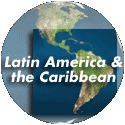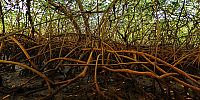
Tamarindo Estuary, Guanacaste
Between Tamarindo and Playa Grande, Costa Rica
5:25 p.m. Local Time - Sept. 22, 2007
Mangrove forests are part of a productive ecosystem that supports abundant life through a food chain that starts with the trees. The leaves of mangrove plants, like all green plants, use sunlight to convert carbon dioxide gas to organic compounds in a process called photosynthesis. The carbon absorbed by plants during photosynthesis, together with nutrients taken up by plants from the soil, provide the raw materials for tree growth. Tree growth is essential in sustaining the life of all other organisms that live in the mangroves. Live and decaying mangrove leaves and roots provide carbon and nutrients that are used by other organisms in the mangrove ecosystem.
Nothing is wasted in a mangrove forest. Mangrove plants shed large numbers of nutrient-rich leaves which are either broken down by fungi and bacteria or are eaten by small crabs that live on the forest floor. Decaying organic material breaks down into small particles (detritus) which are covered with a protein-rich bacterial film. Detritus is the food source for many species of molluscs (snails), crustaceans (crabs, shrimps and prawns) and fish, which in turn are the food source for larger animals. Nutrients released into the water through the breakdown of leaves, wood and roots also feed the plankton and algae that form part of the mangrove ecosystem.
Lat: 10° 19' 6.62" N
Long: 86° 51' 4.74" W
Elevation: 0 m
Precision is: Unknown / Undeclared.



 Tap or click the zoom icon in the bottom right corner of the picture to switch between in-page and fullscreen view
Tap or click the zoom icon in the bottom right corner of the picture to switch between in-page and fullscreen view